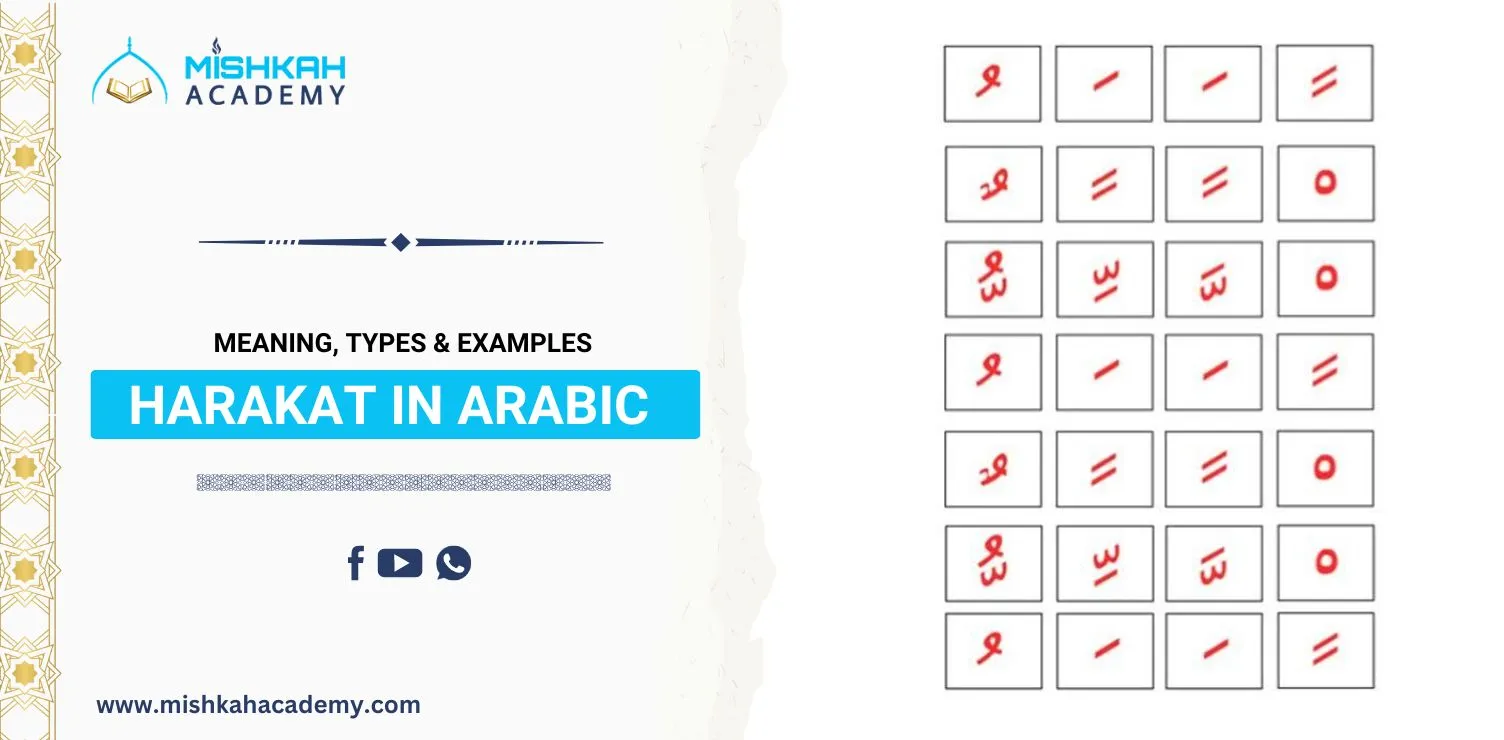Rich in literature, history, and impact, the Arabic language shows both beauty and depth. Harakat, a set of diacritical marks that are crucial for accurate pronunciation and understanding, is a unique feature of the Arabic script. We’ll examine the definition, categories, rules, and significance of harakat in Arabic in this post, studying each element to completely understand its value.
Harakat Meaning
Table of Contents
Toggle“Harakat” (حَرَكَات) is derived from the Arabic root “حَرَكَة” (ḥaraka), which means “movement.” Harakat are symbols that sit above or below letters in the Arabic script to help with pronunciation. They aid in showing phonetic changes and short vowel sounds that the Arabic letter itself does not normally convey.
We will also discuss how many Harakat are there in Arabic, and the difference between Harakat and Tashkeel. We will also give some Harakat examples from the Quran. Also, we will examine Arabic Harakat rules, the benefits of learning Arabic Harakat, and how to learn Arabic Harakat. Finally, we will talk about common mistakes made in applying Harakat and how to avoid them.
What Does Harakat Mean in Arabic?
Harakat are necessary tools for accurate pronunciation in scripts where the majority of the letters are consonants. Arabic uses harakat to indicate vowels and other sounds, in unlike languages based on Latin, where vowels are represented as independent letters. Without them, the way a word is pronounced might give it different meanings. For instance, depending on the harakat used, the root consonants “كتب” (k-t-b) could be interpreted as kitāb (book), kutiba (it was written), or kataba (he wrote).
Harakat are vowel marks above or below Arabic letters. They show the right sound pronunciation. They help readers say words clearly and correctly. Learning to use harakat is a big step in reading and speaking Arabic, especially for Quran recitation.
Understanding Harakat in Arabic
Harakat, the short vowel diacritical marks in Arabic, are key to correct and smooth pronunciation. They are placed above or below letters to show the right vowel sounds. This is crucial for learning Arabic speech and reciting the Quran.
Definition and Purpose
Harakat help Arabic learners and speakers pronounce words right. They show the small differences in vowel sounds, which change a word’s meaning and feel. Using harakat correctly is vital for Tajweed, the art of Quran recitation.
Importance in Pronunciation
Harakat are not just for looks in the Arabic script; they’re the base for correct speech. Without them, it’s hard for non-native speakers to read Arabic well. Learning harakat helps people read and write Arabic better.
“Harakat are the keys to unlocking the true beauty and depth of the Arabic language.”
Learning to use harakat is a big step in understanding Arabic. It’s important for studying the Quran, talking every day, or exploring Arabic literature. Knowing how to use these marks is key to speaking and reading Arabic well.
Types of Harakat in Arabic
In Arabic, there are various forms of harakat that indicate distinct vowel sounds or phonetic changes. Accurately reading, writing, and reciting Arabic requires an understanding of these sorts.
-
Fatha (َ)
A tiny diagonal line called a “fatha” is positioned above a vowel and denotes a short /a/ sound, like the “a” in “cat.” It is among the most easy to learn and widely applied harakat.
Example: “بَ” (ba), where the letter “ب” (bāʾ) with a fatha produces the sound ba.
-
Kasra (ِ)
The short vowel /i/ is represented by the kasra, a little straight line that appears before a consonant and is similar to the “i” in “sit.”
Example: “بِ” (bi), where the letter “ب” (bāʾ) with a kasra produces the sound bi.
-
Damma (ُ)
Damma, which like a tiny loop above a consonant, represents a brief /u/ sound, like the “oo” in “book.”
Example: “بُ” (bu), where the letter “ب” (bāʾ) with a damma produces the sound bu.
-
Sukun (ْ)
Sukun is a small circle placed above a consonant and indicates that the consonant is not followed by a vowel, meaning it should be pronounced without a vowel sound. It is crucial in syllable construction.
Example: “بْ” (b), where the letter “ب” (bāʾ) with a sukun produces the sound b without any vowel.
-
5. Shadda (ّ)
Shadda is a diacritical mark that looks like a small “w” above the letter. It indicates that the consonant it is applied to should be doubled, or pronounced twice.
Example: “بّ” (bb), where the letter “ب” (bāʾ) with a shadda produces the sound bb.
-
Tanwin (ً, ٍ, ٌ)
Tanwin represents the nunation or the addition of an “n” sound at the end of a word. It appears in three forms, depending on the short vowel it is attached to:
Fathatain (ً): Adds an “an” sound to a word.
Example: “كِتَابًا” (kitāban) – “a book.”
Kasratain (ٍ): Adds an “in” sound to a word.
Example: “كِتَابٍ” (kitābin) – “in a book.”
Dammatain (ٌ): Adds an “un” sound to a word.
Example: “كِتَابٌ” (kitābun) – “a book.”
Note: Enroll in the Advance tajweed course to learn Waqf And Ibtida with expert egyptian quran tutors.
Start Your Tajweed Journey Today
What Is Harakat in Arabic?
Harakat (الحركات) are marks above or below Arabic letters. They show how to say letters right. Arabic letters are split into two groups: those with Haraka and those without.
1- Mutahrik (متحرك) (A Letter with a Haraka):
There are three main Harakat: Fatha (َ), Damma (ُ), and Kasra (ِ). A Mutahrik letter has one of these marks. When you say this letter, your lips move in a special way.
“قُلْ هُوَ ٱللَّهُ أَحَدٌ”
The ق letter in “قُلْ” has a Damma (ُ). So, it’s a Mutahrik letter.
2- Sakin (A Letter Without Any Haraka):
A Sakin letter has no Harakat. It’s marked with a small حـ above or has nothing on it.
“قُلْ هُوَ ٱللَّهُ أَحَدٌ”
In “قُلْ”, the لْ letter has a small حـ. So, it’s a Sakin letter.
“مِن شَرِّ مَا خَلَقَ”
In “مِن”, the ن letter has nothing on it. So, it’s a Sakin letter.
Arabic Harakat Rules
Rule 1: Pronunciation Rather Than Writing
In Arabic, harakat are used to guide pronunciation rather than being part of the written word itself. This means that harakat are not typically written in everyday Arabic texts, but are added in contexts where accurate pronunciation is important, like in Quranic text or for learners of the language.
Example:
The word كتب can be read as kataba (he wrote), kutiba (it was written), or kitāb (book), depending on the harakat used. Without harakat, the letters remain the same, but the pronunciation and meaning change.
2- How Do Arabs Use Mutahrik And Sakin?
Arabs have a simple rule:
.“العرب لا تبدأ بساكن ولا تقف على متحرك”
[Arabic speakers do not start with a Sakin letter and do not end with a Mutahrik letter].
This means the first letter of any word must be Mutahrik. The last letter of a syllable must be Sakin.
“وَٱلْعَصْرِ”
In this verse, the first letter is Mutahrik. The last letter (ر) has two cases:
A- If the reciter stops at it and makes Ibtida [starts anew] with the next verse, the ر letter is Sakin. So, the ر sound is pronounced without any Harakat.
How does Haraka Affect the Meaning in the Quran?
In Arabic, the subject (the doer of the action – الفاعل) in the sentence has the Damma (ُ) at the end of the word if it is singular. The object in the sentence has the Fatha () at the end of the word if it is singular. Let’s look at an example from the Quran:
Allah says:
“إِنَّمَا يَخْشَى ٱللَّهَ مِنْ عِبَادِهِ ٱلْعُلَمَـٰٓؤُا۟ ۗ”
In this verse, the word “الله” must be pronounced as “Allaha” [اللهَ]. Saying it as “Allaho” [اللهُ] changes the meaning. It would mean Allah fears His knowledgeable servants, not the other way around. The correct pronunciation keeps the verse’s true meaning: Allah is feared by His knowledgeable servants.
This example shows how wrong Haraka can change a verse’s meaning. Learning Harakat is key to keeping the Quran’s meaning intact.
How does Haraka Affect the Meaning of a Single Word?
A single word can have different meanings based on its Haraka.
For example:
The word عقد has 3 letters (ع ق د). It can mean 6 different things depending on its Haraka. Here are the meanings:
- “عُقْد”: means “Necklace”,
- “عِقد”: means “Decade”,
- “عَقْد”: means “Contract”,
- “عَقَدَ”: means “Held”,
- “عَقَّدَ”: means “Complicated”,
- “عُقَّدْ”: means “Knots”.
Importance of Harakat in Arabic
The use of harakat in Arabic cannot be overstated. They are fundamental to reading, writing, and understanding the language. Let’s examine why they are so crucial:
- Proper pronunciation: Words in Arabic can mean very different things depending on how they are pronounced. By ensuring that the right vowels are pronounced, harakat facilitates reading and understanding of the language. Without harakat, it would be simple for a reader to misunderstand a text, which could result in errors or confusion.
- Beginning Arabic Language Instruction: Harakat are an essential resource for learning Arabic for novices, particularly non-native speakers. They assist students better understand the language’s structure and provide a clear guide to pronunciation.
- Poetry and Literature: Arabic poetry, known for its rhythm and rhyme, relies heavily on the correct application of harakat to maintain meter and flow. Poets often use harakat to manipulate sounds for artistic effect, making them essential in literary works.
Start Your Tajweed Journey Today
What is Harakah in Tajweed!
Harakat in Tajweed are key for correct Quran recitation. They deal with the timing of each letter’s pronunciation. Let’s dive into this:
Harakat As A Length Of Pronouncing A Letter: Each letter has a specific number of Harakat. One Haraka is like one finger count. Here’s a closer look:
1. Constants:
Usually, a constant takes only 1 Haraka.
“قُلْ هُوَ ٱللَّهُ أَحَدٌ”
Each letter in “أحد” gets only 1 Haraka.
2. Normal Madd:
The normal Madd (extension) of the 3 Arabic letters (أ و ي) is 2 Harakat, each. So, an Arabic person with perfect pronunciation will normally give these 2 Harakat when reading any of أ و ي letters.
“وَٱلتِّينِ وَٱلزَّيْتُونِ ١ وَطُورِ سِينِينَ ٢ وَهَـٰذَا ٱلْبَلَدِ ٱلْأَمِينِ ٣ لَقَدْ خَلَقْنَا ٱلْإِنسَـٰنَ فِىٓ أَحْسَنِ تَقْوِيمٍۢ”
In these 4 verses, all و and ي letters have 2 Harakat. So, if the word “وَٱلتِّينِ” is given only 1 Haraka, the recitation (Tajweed) of this word will be incorrect.
3. Other Kinds Of Madd:
There are other types of Madd in the Quran that have to be 4-6 Harakat. Some of them are mandatory and some are optional.
“وَلَا ٱلضَّآلِّينَ”
In this part of the verse, the “آ” sound in the word ٱلضَّآلِّينَ needs to have 4 Harakat, while the “يـ” sound in the same word should have 6 Harakat so that the recitation of this word is correct.
To sum up, Harakat, in this sense, is used to organize how long a letter will be pronounced so that the recitation will be correct.
What is the Difference Between Harakat and Tashkeel?
Now, let’s explore the difference between Harakat and Tashkeel in Arabic. First, we need to define “Tashkeel”. Tashkeel is a system of diacritics used in Arabic writing. It shows how to pronounce letters. It’s key for reading Arabic text right, especially for those new to the language.
“ٱلْحَمْدُ لِلَّهِ رَبِّ ٱلْعَـٰلَمِينَ”
In this verse, the Tashkeel (diacritics) are shown by signs like:
ًّ ْ ُ ِ ّ
Tashkeel guides readers to read words correctly. It helps make Harakat accurate. So, Tashkeel is the written sign, and Harakat is the practical part of the language.
Learn Arabic Harakat With Mishkah Academy
Learning Harakat is crucial, especially when reading the Quran. Here are some easy steps to help you:
To learn Arabic Harakat, start with basic Arabic Grammar and Noorani Qaida Course. Mishkah Academy offers top online Tajweed and Arabic courses. Join our Arabic Course for Kids and Tajweed Course at Mishkah Academy. Find an Egyptian Quran Tutor for guidance and feedback. They can help you improve your recitation. Listen to an experienced teacher and repeat after them. They will correct your mistakes. At Mishkah Academy, many qualified Quran mentors are ready to help.






